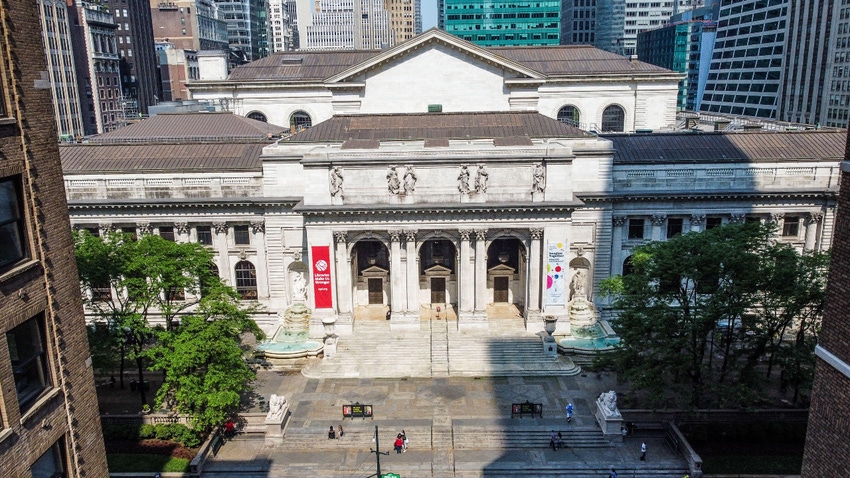New York library to offer Internet through fixed wireless, fiber
The New York Public Library system tested fixed wireless Internet services at a handful of locations in 2022 in reaction to COVID-19 shutdowns across the city. Now, library officials are moving to phase two.

The New York Public Library system was founded in 1895, just a few years after Thomas Edison lit the first electrical light in the city and shortly before Henry Ford introduced the Model T.
Today, the library is looking to offer Internet services to low-income New Yorkers through a cutting-edge mix of fixed wireless access (FWA) and fiber. According to Garfield Swaby, VP of IT for New York Public Library (NYPL), it's all part of the library's mission to bring information to its patrons.
"That's part of our core competency as a library," he said.
"We don't see ourselves as competing with the Verizons and the Comcasts of the world," Swaby explained to Light Reading. Instead, he sees NYPL as potentially offering a layer of telecom services alongside the Affordable Connectivity Program (ACP), which provides subsidies to low-income Americans to help them pay for telecom services.
Part of the library's goal is to make sure "New Yorkers would always have that broadband dial-tone offered by the library," Swaby said. "Our thing is not to maximize stockholders' wealth, but instead to help New Yorkers bridge the digital divide."
The shutdown
The COVID-19 pandemic, and its resulting shutdowns across New York City, sparked the new project by NYPL. Swaby said library officials noticed residents at some of the library system's 92 locations in the Bronx, Manhattan and Staten Island sitting outside the buildings in order to log into the library's Wi-Fi networks.
"There was a need there," he said.
In response, library officials in New York and elsewhere started looking for ways to broadcast their buildings' Internet connections into nearby neighborhoods.
Swaby came across a school system in Utah using fixed wireless equipment in the unlicensed 3.5GHz CBRS spectrum band to beam Internet connections into students' homes. "That was eye opening," he said.
Indeed, as Light Reading has previously reported, a wide range of schools, local governments and other entities embarked on FWA deployments to keep students and others connected during pandemic lockdowns. But, as Swaby explained, those kinds of deployments were relatively rare in massive metropolitan areas like New York City.
The trial
Using funds from JPB Foundation, S&P Global and others, NYPL invited a handful of fixed wireless equipment suppliers to set up networks on top of five different NYPL library locations. The project tested radio equipment from Motorola, Celona and Baicells, and customer premises equipment (CPE) from Ericsson's Cradlepoint and Inseego, according to Swaby. Sky Packets also served as an integrator and partner.
Library officials checked out CPE signal receivers to residents within range of their CBRS networks, ultimately delivering equipment and Internet connections to more than 100 New York households.
"Phase 1 of the trial was fairly successful," Swaby said, noting the project ran through most of the summer of 2022. However, he said it was very much a test effort: "We didn't want to spend too much before we knew the technology would work."
The library system's main learning was that CPE receivers for FWA systems are expensive, and in some cases library patrons did not return the gadgets.
As a result, Swaby said NYPL is now pursuing a slightly different strategy for phase two of its Internet effort. The library system is bidding on several requests for proposal (RFPs) that would have the library deliver its Internet service to apartments housing low-income residents that are close to its libraries, using either fixed wireless or fiber depending on the scenario. Residents would be able to access the library's Internet through their building's Wi-Fi system, logging in with their library card.
The takeaways
"I don't think we're at a point where I can recommend we can move ahead at scale with a single vendor," Swaby said of NYPL's experiences with fixed wireless. He said that such services are still relatively difficult to offer and manage. For example, the NYPL had to develop its own application to manage equipment and devices across several different vendors.
Broadly, the fixed wireless and private wireless marketplace needs to mature further before it's ready for prime time, Swaby said.
NYPL's work in the CBRS spectrum band was touted by the OnGo Alliance at its recent meeting in the Dallas-Fort Worth area. The alliance continues to promote the value of the unlicensed CBRS spectrum band, which relies on an innovative spectrum-sharing setup. The 5G industry, however, has argued that this kind of sharing setup is inefficient when compared with an exclusive spectrum-licensing design.
The testing by NYPL is also relevant to the broader discussion about private wireless networks. Such networks promise enterprises, government users and others a network dedicated to their needs, and the needs of their patrons. However, the private wireless networking space isn't developing as quickly as some in the industry had hoped.
About the Author(s)
You May Also Like



.jpg?width=300&auto=webp&quality=80&disable=upscale)








